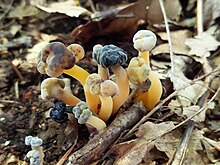Leotia lubrica
Leotia lubrica, commonly referred to as a jelly baby, is a species of fungus in the family Leotiaceae.
L. lubrica was first validly described by Giovanni Antonio Scopoli, but it was later transferred to Leotia by Christiaan Hendrik Persoon.
Ochre with tints of olive-green, the heads are irregularly shaped, while the stalk, of a similar colour, attaches them to the ground.
The appearance can be somewhat variable and is similar to a number of other species, including Cudonia confusa, C. circinans, L. atrovirens and L. viscosa.
[3] Other synonyms include Leotia gelatinosa, used by John Hill in 1751,[Note 1][5] Helvella gelatinosa, used in Jean Baptiste François Pierre Bulliard's Histoire des champignons de la France,[3][6] and Peziza cornucopiae, a name given by Georg Franz Hoffmann in 1790.
[15] In 2004, results of phylogenetic analysis suggested that L. lubrica, L. atrovirens and L. viscosa, while morphologically well-defined, were not monophyletic.
The species can be differentiated by the fact that L. lubrica fruit bodies are more sturdy, and those of C. confusa are much paler in colour.
[9] L. viscosa can again be differentiated by colouration; the species has a green head,[19] although L. lubrica fruit bodies can also be greenish.
[8] Fruit bodies are typically found growing in large numbers,[8] sometimes in clumps,[11] though solitary specimens are occasionally encountered.
[17] While it has been conventionally regarded as a saprotroph,[19] molecular, isotopic and other lines of evidence have suggested that L. lubrica forms ectomycorrhizae.
[23] Its fruit bodies are of little culinary interest,[20] and, contrary to what is suggested by the common name, are often described as inedible by field guides.
[25] L. lubrica fruit bodies have been found to contain low levels of monomethylhydrazine, a toxic chemical associated with the poisonous false morel Gyromitra esculenta.


